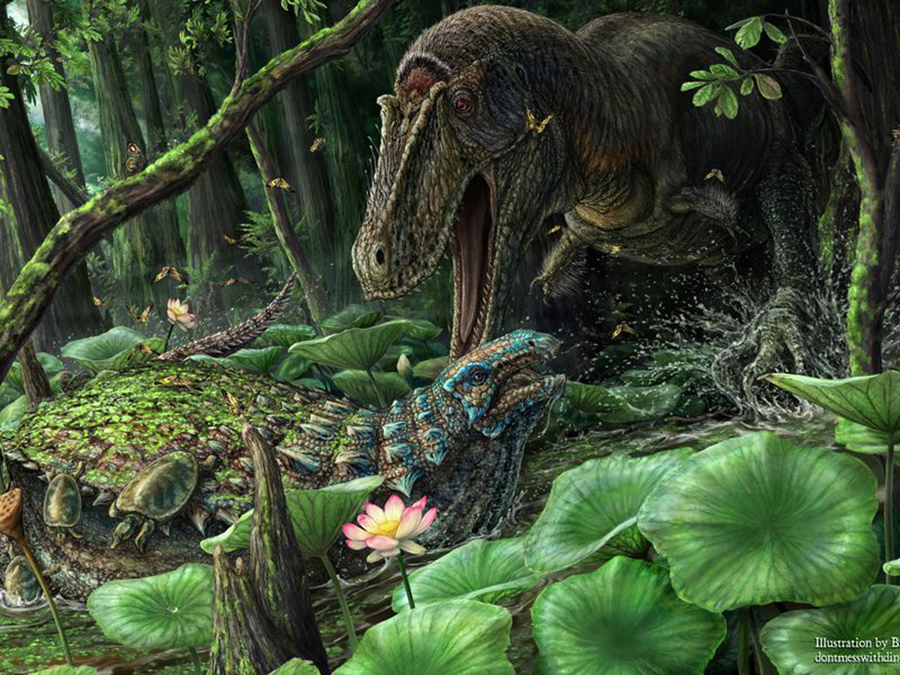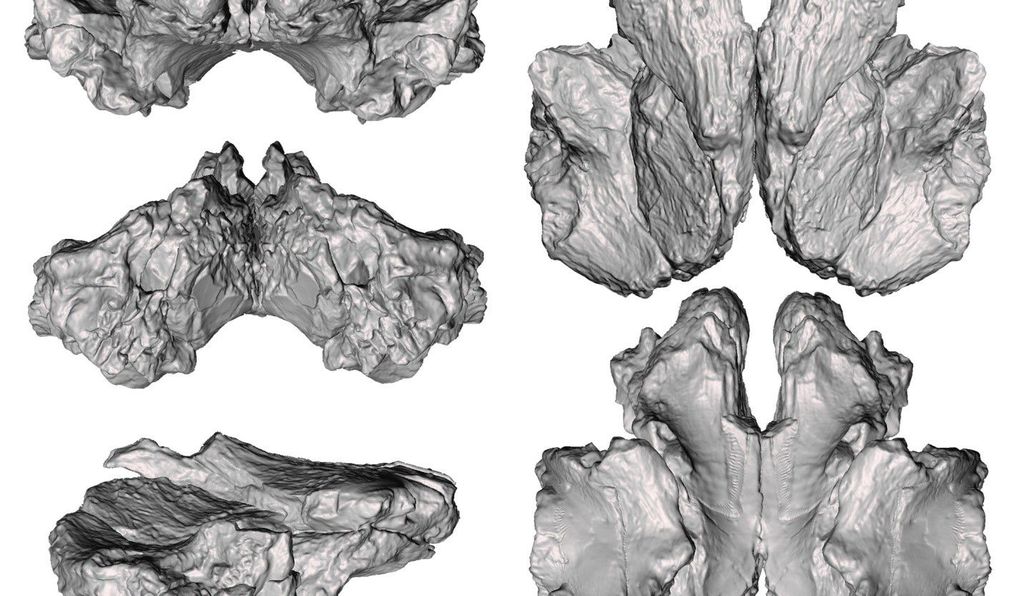Dynamoterror dynastes: Newly Discovered Tyrant Dinosaur Stalked Ancient New Mexico

The Dynamoterror, a relative of Tyrannosaurus rex, lived millions of years before other known species of tyrannosaur.
Tyrannosaurs often bear fierce names. Aside from the “tyrant lizard” Tyrannosaurus itself, there’s the “monstrous murderer” Teratophoneus, the “frightful lizard” Daspletosaurus, and the “gore king” Lythronax. But a new set of tyrannosaur bones extracted from the 80-million-year-old rock of New Mexico may have one of the most imposing names of all—Dynamoterror dynastes, the “powerful terror ruler.”
The remains of Dynamoterror were found in New Mexico’s Menefee Formation in 2012 during an expedition led by Western Science Center paleontologist Andrew McDonald and CEO of the Zuni Dinosaur Institute for Geosciences, Douglas Wolfe. During that year’s field season, expedition volunteer Eric Gutierrez found fragmented bones spilling out of the sandstone.* Dinosaurs are hard to find in this part of the San Juan Basin, making almost any find worth noting, but initial clues indicated that this find was something special.
“We could tell that it was a large theropod from the large fragments of hollow limb bones,” McDonald says, referring to the broader family that tyrannosaurs, ostrich mimic dinosaurs, raptors, birds and others belong to.
Time had not been kind to the bones of Dynamoterror, breaking and scattering the bones. It took years of puzzling together the recovered shards before the critical fragments—a pair of telltale skull bones called frontals—were pieced together, revealing the fossil’s identity as a previously-unknown tyrannosaur. The dinosaur is described in a paper published in PeerJ.
Although the fossil is scrappy, it still adds context to the broader picture of the roughly 25 distinct tyrannosaurs known so far. Not only is Dynamoterror new, but it falls in a specific tyrannosaur subgroup that contains some of the last and largest of the species, like T. rex itself.
T. rex lived between 68 and 66 million years ago, and many of its famous relatives—like Gorgosaurus and Albertosaurus—lived about 75 million years ago. Dynamoterror and its relative Lythronax from Utah are more ancient still, about 80 million years old. “This indicates that derived tyrannosaurs must have arisen at an even earlier date” than previously expected, New Mexico Museum of Natural History and Science paleontologist Thomas Williamson says. The find points to an older, as-yet-unknown diversification of these famous carnivores.

In life, McDonald and colleagues hypothesize, Dynamoterror would have been about 30 feet long. Far larger than the earliest tyrannosaurs, though not quite as big as the celebrity T. rex, Dynamoterror is comparable in size to a few other tyrannosaurs of similar age—large enough to earn top predator status in its ancient realm.
Back in this tyrannosaur’s heyday, McDonald says, “the Menefee would have been much like the swamps and forest of the southeastern U.S.—hot, humid, and lush.” Shovel-beaked hadrosaurs, armored dinosaurs, and horned dinosaurs were some of the neighbors Dynamoterror rubbed shoulders with and likely preyed upon.
What makes Dynamoterror stand out, however, is that it’s another piece in an emerging picture of dinosaur evolution running riot between 80 and 75 million years ago. Back in the Late Cretaceous, North America was split in two by the Western Interior Seaway, a warm stretch of water that washed over the middle of the continent, with the western half known to experts as Laramidia. From the stony records of this subcontinent, paleontologists have been finding a slew of unexpected dinosaurs.
Historic finds in the northern parts of Laramidia, such as modernday Alberta and Montana, revealed rich communities of dinosaurs such as tyrannosaurs, horned dinosaurs, armored dinosaurs and more. Fossils found in southern rocks of the same age were often given the same names as the northern species. But in the past three decades, paleontologists have started to put together a very different picture. New discoveries and fossil revisions have shown that the dinosaurs found in Utah, New Mexico, Texas and Mexico were not the same as those found in the north. If you were to walk from Mexico to Alaska 80 million years ago, you’d find a gradient of different dinosaurs as you hiked along.
Dynamoterror is part of this story, and an important one as it’s from an area with few known fossils. No dinosaurs had been named from the Menefee Formation until earlier this year, when an armored dinosaur called Invictarx was identified. Dynamoterror is now the second, and the fact that it differs from other known tyrannosaurs of a similar age indicates that there were distinct evolutionary pockets along the length of the ancient subcontinent.
The new tyrannosaur also points to what may yet be found. Both Dynamoterror and Lythronax are from southern North America and are about 80 million years old. There seems to be a bias against the preservation of dinosaurs in rocks of this age, Williamson says, but the few and often scrappy fossils that have turned up have indicated that dinosaur diversity was just as rich as it was in the 75-million-year-old rocks where preservation is better.The search is taxing, but it means there are more dinosaurs to dig up.
Some of them will likely be tyrannosaurs. To the north, McDonald says, “roughly contemporaneous rocks have yet to produce diagnostic tyrannosaurid material.” It could very well be that there were other unusual tyrant lizards in northern Laramidia, now entombed in the rocks, waiting to be uncovered and help fill in the picture of how these tyrants came to rule North America.
Source: www.smithsonianmag.com








